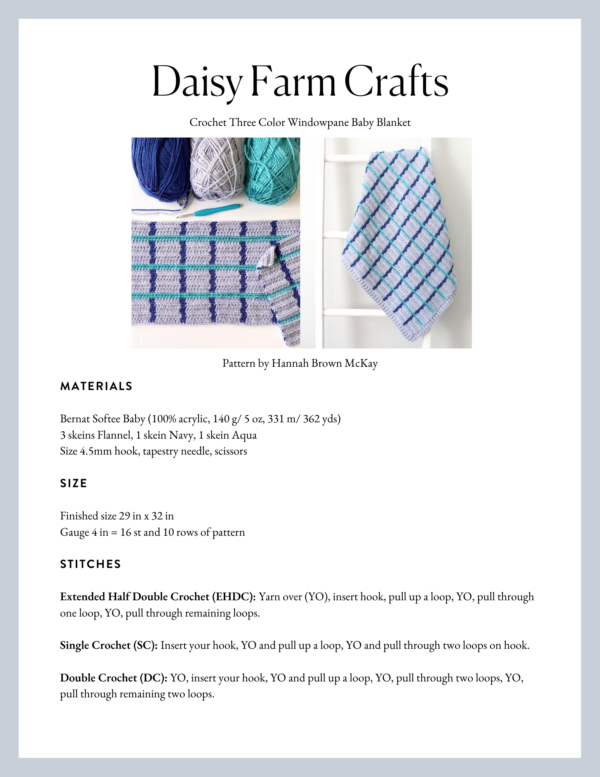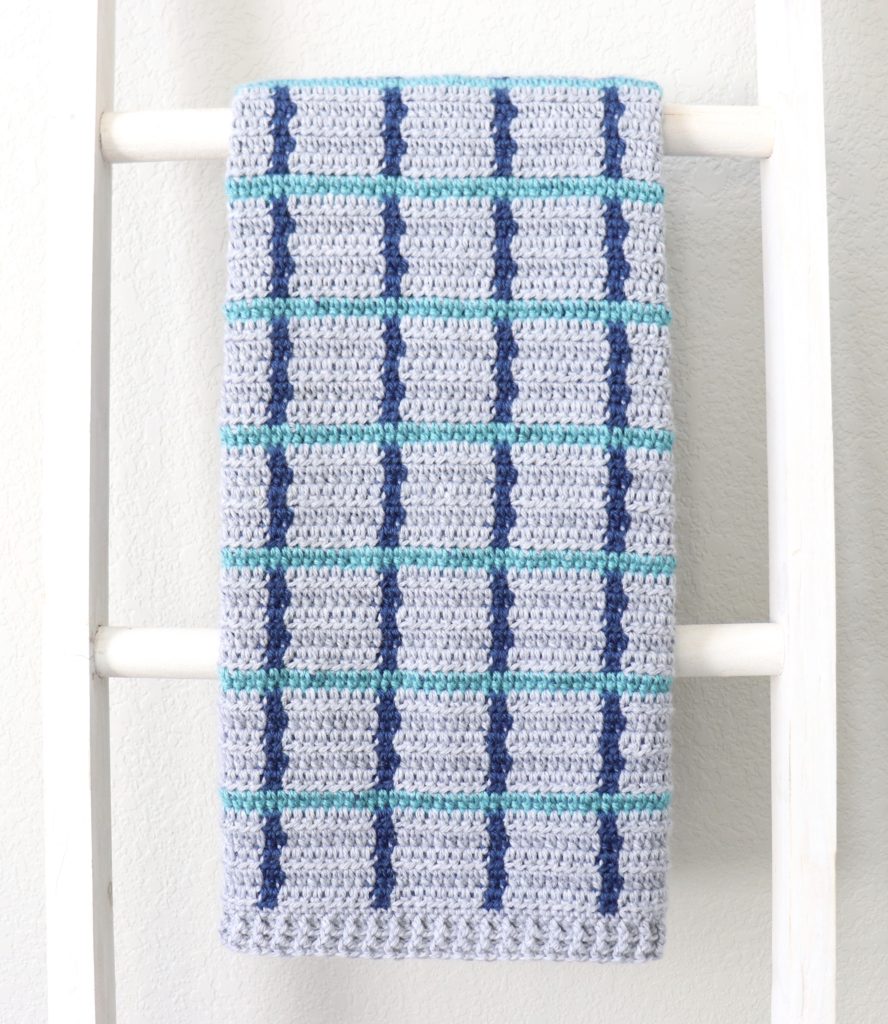
Hello, Hannah here, I made another version of a windowpane blanket, this time using three colors instead of two!
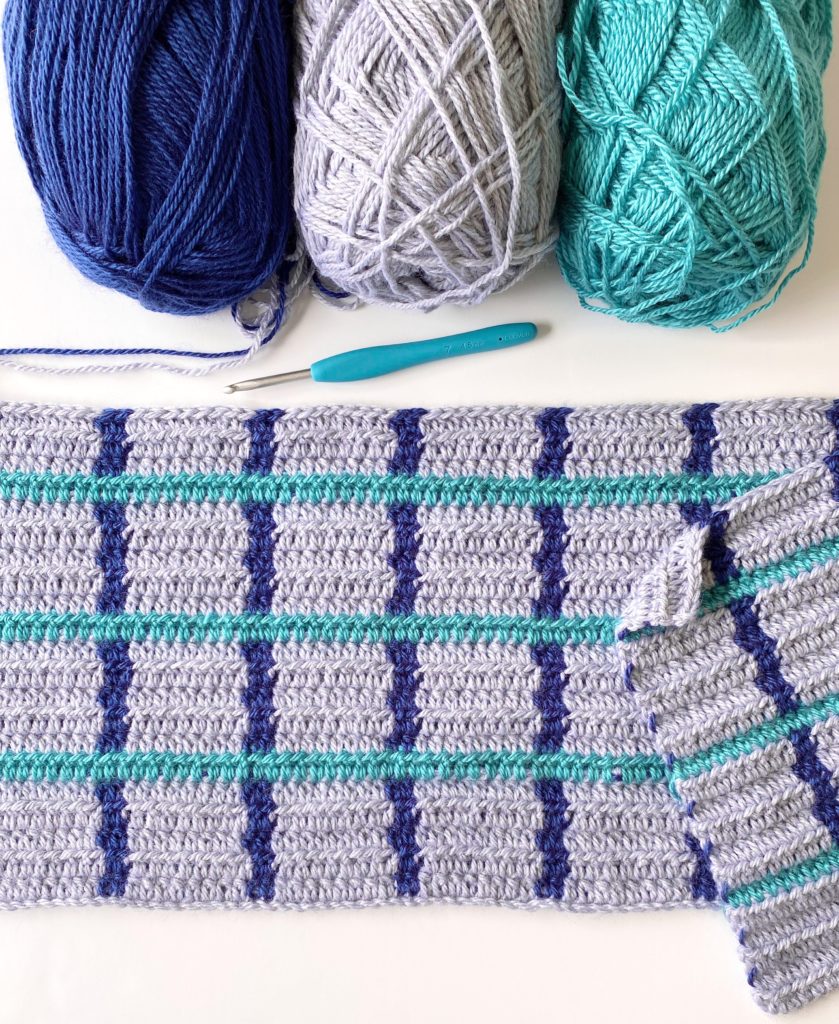
If you’ve been to Daisy Farm Crafts before, you’ll know that we love to make gingham blankets using the technique of carrying yarn so we can easily change colors, which is what I did for this blanket. It’s a little bit tricky to figure out the tension at first, so if you’ve never carried yarn through a blanket before, I would recommend working up a small practice swatch before you get started. Once you get the hang of it I think you’ll see that it’s easier than it looks!
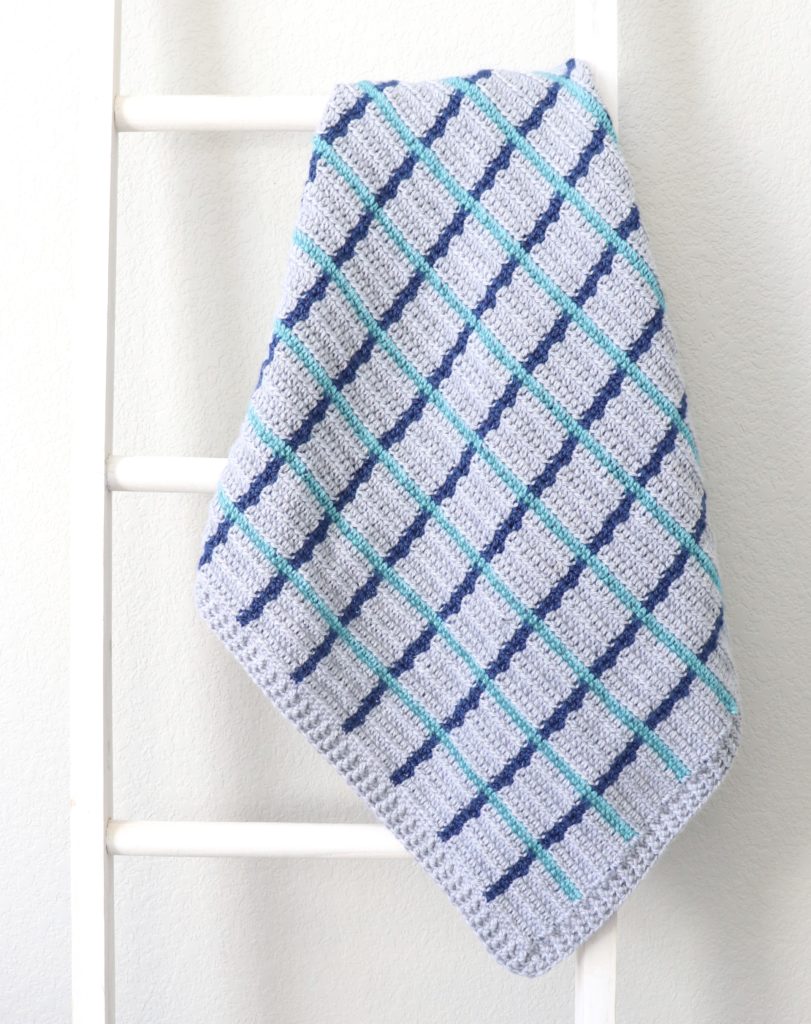
We don’t have a full video tutorial for this blanket, but below is a quick clip you can watch that shows how I am carrying the yarn and crocheting over it as I go. If you’d like more visual help, you might want to check out our Windowpane Gingham Blanket video tutorial – the stitches and counting and slightly different, but the yarn carrying technique is the same.
Materials
Bernat Softee Baby (100% acrylic, 140 g/ 5 oz, 331 m/ 362 yds)
3 skeins Flannel, 1 skein Navy, 1 skein Aqua
Size 4.5mm hook, tapestry needle, scissors
Size
Finished size 29 in x 32 in
Gauge 4 in = 16 st and 10 rows of pattern
Stitches
Extended Half Double Crochet (EHDC): Yarn over (YO), insert hook, pull up a loop, YO, pull through one loop, YO, pull through remaining loops.
Single Crochet (SC): Insert your hook, YO and pull up a loop, YO and pull through two loops on hook.
Double Crochet (DC): YO, insert your hook, YO and pull up a loop, YO, pull through two loops, YO, pull through remaining two loops.
Front and Back Post Double Crochet (FPDC & BPDC): A front post double crochet means you insert your hook from front to back around the post of the next DC and work a DC. A back post double crochet means you insert your hook from back to front around the post of the next DC and work a DC.
Pattern
With Flannel, chain 110. (To make your blanket larger, chain any multiple of 10.)
ROW 1: Starting in the third chain from the hook, work an EHDC in the first 8 chains with Flannel. Before you complete the stitch on the 8th stitch, pull through with Navy. Work 2 EHDCs with Navy, crocheting over the Flannel and carrying it along the top of your work as you go. *Work 8 EHDCs with Flannel, then 2 EHDCs with Navy, always crocheting over whichever color you aren’t using and carrying it along the top of your work. Repeat from * to the end of the row, where you should end with 8 EHDCs in Flannel. Chain 2 and turn. (108 stitches made. The chain 2 does not count as a stitch.)
Note: To avoid your yarn getting twisted as you switch back and forth between colors, it helps to always keep the Flannel to the back of your work and the Navy to the front of your work each time you switch.
ROW 2: Wrap the Navy around the side of your work, and carry it along the top of your work as you continue the pattern of *8 EHDCs in Flannel, then 2 EHDCs in Navy, always crocheting over whichever color you aren’t using. Repeat from * to the end of the row, where you should end with 8 EHDCs in Flannel. Chain 2 and turn.
ROWS 3 – 5: Repeat row 2.
ROW 6: Work one row of EHDC with Aqua. Carry both the Flannel and Navy along the top of your work so you can easily pick them up when you finish the row. On the last stitch of the row, pull through with Flannel before you finish the stitch, then chain 2 and turn. Cut the Aqua and leave a long tail you can weave into the blanket later.
ROWS 7 – 11: Repeat row 2.
Repeat rows 6 through 11 for the remainder of the blanket. I ended up with 11 Aqua rows when my blanket was the length I wanted.
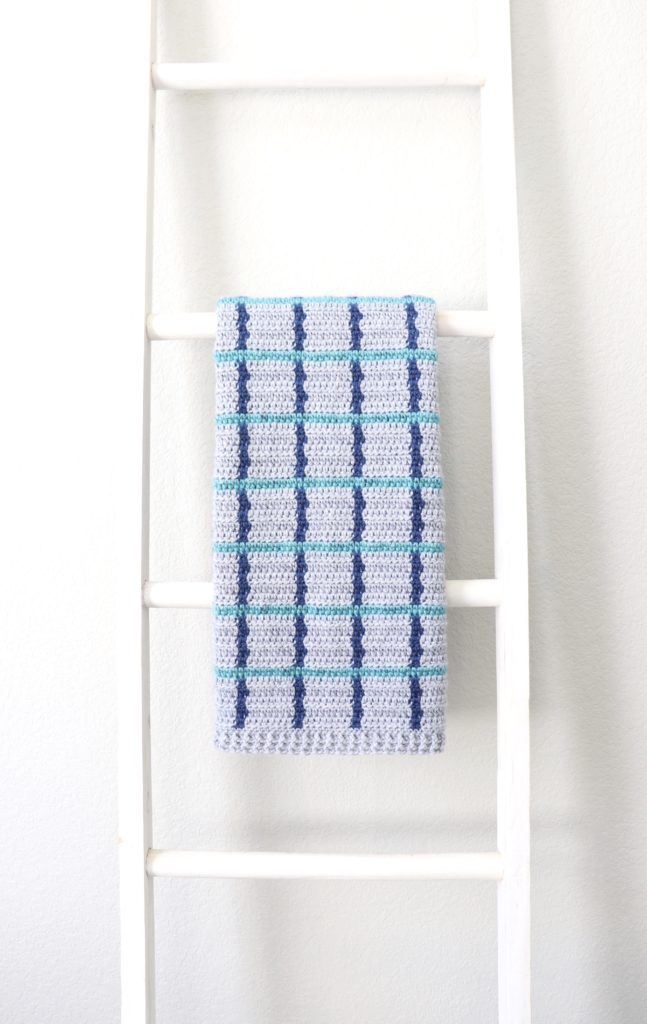
Border
Weave in all ends with a tapestry needle.
Round 1: Pull up a loop in any corner and chain 1. Work one round of SC around the blanket, working 3 SCs into each corner. (On the sides, try to work two SCs per row, so you should have 10 SCs for each Flannel section and 2 SCs for each Aqua row.) When you reach the corner you started with, slip stitch into the corner, then chain 3 and turn.
Round 2: Work one round of DC around the blanket, working 3 DCs into each corner. When you reach the corner you started with, work 3 DCs into starting corner.
Round 3: Continue working in the same direction and work one round of alternating front and back post double crochet. When you get to the corners of this round, you will want to continue the pattern of alternating front and back post double crochet, but you will work three stitches around the corner post.
So, for example, if you get to the corner post and you are supposed to work a front post DC, then work a front post DC, a back post DC, and a front post DC all around that corner post. Then in the next stitch you would continue the alternating pattern, working the opposite of whichever stitch you just used (in this example, you would work a back post DC). Just remember that you are always alternating front and back post double crochet around the whole blanket, you just happen to be working three of those stitches around the same post when you are working the corners.
Round 4: When you finish round 3, work 3 alternating front post/back post DCs into the corner you started with and repeat round 3 around the blanket. Always match your post double crochets so that they are poking out in the same direction as the row below. You can go around as many times as you’d like to get your desired border height. When you’ve finished your last round, slip stitch into the starting corner and tie off.
Here’s a video you can watch for this border:
If you’d like to add finishing touches to your blanket, lay it out flat on a towel or foam blocking boards if you have them. Use a spray bottle with water to dampen the blanket. Press the blanket into straight lines, massaging the stitches and adjusting your tension. Pin with straight pins and let it dry.

Thank you so much for visiting Daisy Farm Crafts and best of luck with your blanket! When you’re finished, please come share a picture with us on Facebook or Instagram using #daisyfarmcrafts, we’d love to see! xo, Hannah
Click here or on image below for printable pattern
Crochet Three Color Windowpane Baby Blanket

Materials
- Bernat Softee Baby yarn (100% acrylic, 140g / 5 oz, 331 meters / 362 yards)
- -3 balls Flannel, 1 ball Navy, 1 ball Aqua
- Size 4.5mm hook
- Tapestry Needle
- Scissors
- Finished size: 29 in x 32 in
- Gauge: 4 in = 16 stitches and 10 rows
Instructions
STITCH
Extended Half Double Crochet (XHDC): Yarn over (YO), insert hook, pull up a loop, YO, pull through one loop, YO, pull through remaining loops.
PATTERN
With Flannel, chain 110. (To make your blanket larger, chain any multiple of 10.)
ROW 1: Starting in the third chain from the hook, work an XHDC in the first 8 chains with Flannel. Before you complete the stitch on the 8th stitch, pull through with Navy. Work 2 XHDCs with Navy, crocheting over the Flannel and carrying it along the top of your work as you go. *Work 8 XHDCs with Flannel, then 2 XHDCs with Navy, always crocheting over whichever color you aren't using and carrying it along the top of your work. Repeat from * to the end of the row, where you should end with 8 XHDCs in Flannel. Chain 2 and turn. (108 stitches made. The chain 2 does not count as a stitch.)
Note: To avoid your yarn getting twisted as you switch back and forth between colors, it helps to always keep the Flannel to the back of your work and the Navy to the front of your work each time you switch.
ROW 2: Wrap the Navy around the side of your work, and carry it along the top of your work as you continue the pattern of *8 XHDCs in Flannel, then 2 XHDCs in Navy, always crocheting over whichever color you aren't using. Repeat from * to the end of the row, where you should end with 8 XHDCs in Flannel. Chain 2 and turn.
ROWS 3 - 5: Repeat row 2.
ROW 6: Work one row of XHDC with Aqua. Carry both the Flannel and Navy along the top of your work so you can easily pick them up when you finish the row. On the last stitch of the row, pull through with Flannel before you finish the stitch, then chain 2 and turn. Cut the Aqua and leave a long tail you can weave into the blanket later.
ROWS 7 - 11: Repeat row 2.
Repeat rows 6 through 11 for the remainder of the blanket. I ended up with 11 Aqua rows when my blanket was the length I wanted.
BORDER
Single Crochet: Insert hook, pull up a loop, YO, pull through two loops.
Double Crochet: YO, insert hook, pull up a loop, YO, pull through two loops, YO, pull through remaining two loops.
Front Post Double Crochet: Insert your hook from front to back around the post of the next DC and work a DC.
Back Post Double Crochet: Insert your hook from back to front around the post of the next DC and work a DC.
Weave in all ends with a tapestry needle.
Round 1: Pull up a loop in any corner and chain 1. Work one round of SC around the blanket, working 3 SCs into each corner. (On the sides, try to work two SCs per row, so you should have 10 SCs for each Flannel section and 2 SCs for each Aqua row.) When you reach the corner you started with, slip stitch into the corner, then chain 3 and turn.
Round 2: Work one round of DC around the blanket, working 3 DCs into each corner. When you reach the corner you started with, work 2 DCs around the starting chain 3.
Round 3: Continue working in the same direction and work one round of alternating front and back post double crochet. When you get to the corners of this round, you will want to continue the pattern of alternating front and back post double crochet, but you will work three stitches around the corner post.
So, for example, if you get to the corner post and you are supposed to work a front post DC, then work a front post DC, a back post DC, and a front post DC all around that corner post. Then in the next stitch you would continue the alternating pattern, working the opposite of whichever stitch you just used (in this example, you would work a back post DC). Just remember that you are always alternating front and back post double crochet around the whole blanket, you just happen to be working three of those stitches around the same post when you are working the corners.
Round 4: When you finish round 3, work 3 alternating front post/back post DCs into the corner you started with and repeat round 3 around the blanket. Always match your post double crochets so that they are poking out in the same direction as the row below. You can go around as many times as you’d like to get your desired border height. When you've finished your last round, slip stitch into the starting corner and tie off.
If you’d like to add finishing touches to your blanket, lay it out flat on a towel or foam blocking boards if you have them. Use a spray bottle with water to dampen the blanket. Press the blanket into straight lines, massaging the stitches and adjusting your tension. Pin with straight pins and let it dry. Here is a link to a YouTube video tutorial for this border if you’d like more help: https://youtu.be/HfNim96QLGs

